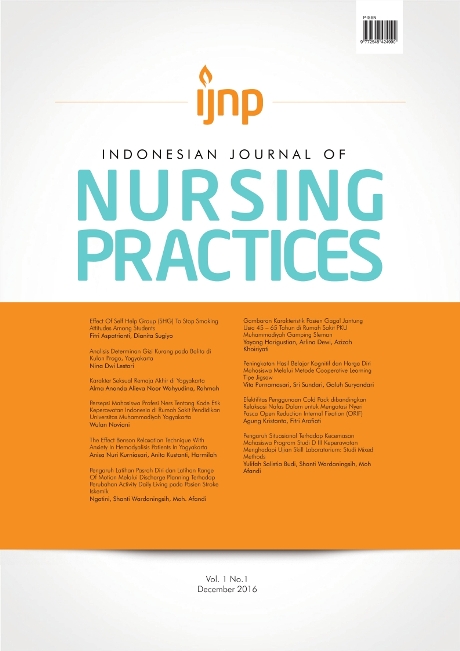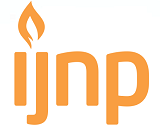REMAJA BISA MENCEGAH GIZI LEBIH DENGAN MENINGKATKAN SELF-EFFICACY DAN KONSUMSI SAYUR-BUAH (Adolescents can prevent overweight with increasing self-efficacy and vegetable-fruit consumption)
DOI:
https://doi.org/10.18196/ijnp.v1i2.3434Keywords:
Gizi Lebih, Konsumsi Sayuran dan Buah, Obesitas, Remaja, Self-efficacyAbstract
Abstrak
Prevalensi gizi lebih pada remaja setiap tahunnya mengalami peningkatan. Gizi lebih merupakan suatu masalah yang kompleks yang dipengaruhi oleh banyak faktor, salah satunya kurangnya konsumsi sayuran dan buah. kurangnya konsumsi sayuran dan buah di asumsikan tidak adanya keyakinan (self-efficacy) pada remaja untuk mengonsumsi sayuran dan buah karena beberapa hal. Tujuan dari penelitian ini adalah untuk mengetahui hubungan self-efficacy dengan konsumsi sayuran-buah dan kejadian gizi lebih. Metode yang digunakan adalah crossectional. Jumlah sampel yang digunakan adalah 156 remaja kelas 7 dan 8. Tekhnik pengambilan sample yang digunakan adalah stritified propotional random sampling. kuesioner yang digunakan adalah Self-efficacy for fruit, vegetable and water intake dan food recall. Penelitian ini menunjukan bahwa self-efficacy berhubungan dengan konsumsi sayuran dan buah dan kejadian gizi lebih (OR=9,467, 2,093). Hasil regersi logistik menunjukan preferensi merupakan variabel confounding pada konsumsi sayuran dan buah. sedangkan jenis kelamin, genetik dan konsumsi sayuran dan buah merupakan variabel confounding dari gizi lebih.
Abstract
The prevalence of overweight in adolescents each year has increased. Overweight is a complex issue that is influenced by many factors, one of the cautions is the lack of consumption vegetables and fruit. Lack of consumption vegetables and fruit in the adolescents is assumed to be absence of confidence (self-efficacy) in adolescents to eat vegetables and fruit for several reasons. The purpose of this study was to determine the relationship self-efficacy with vegetable-fruit consumption and the incidence of overweight. The method of research used way cross sectional. A total samples of 156 teenagers grade 7 and 8 in Junior high schools was involved in this study. Using stratified proportional random sampling. The questionnaires used are Self-efficacy for Fruit, Vegetable and Water Intake and Food Recall. This study showed that self-efficacy associated with the consumption of vegetables and fruit and the incidence of overwight (OR=9,467, 2,093).. The results of regresion logistic showed preferences had confounding variable in the consumption of vegetables and fruit. whereas gender, genetics and consumption of vegetables and fruit is a confounding variable of nutrition
References
Annesi, James J. (2011). Relationship of initial self-regulatory ability with changes in self-regulation and associated fruit and vegetable consumption in severely obese women initiating an exercise and nutrition treatment: moderation of mood and self-efficacy. Journal of Sports Science and Medicine (2011) 10, 643-648
CDC (2010). Healthty youth, coordinate Scholl Health. Http//www.cdc.gov/healthtyyouth/CSHPP. Diakses tanggal 10 februari 2016.
Chung, S. J., & Hoerr, S. L. (2005). Predictors of fruit and vegetable intakes in young adults by gender. Nutrition Research, 25, 453–463
Guillaumie, L., Godin, G., & Vezina Im, L.A. (2010). Psychosocial determinants of fruit and vegetable intake in adult population: A systematic review. International Journal of Behavioral Nutrition and Physical Activity, 7, 1–12
Guillaumie, Laurence., Gaston., Jeans-Claude M., Elisabeth S., Laurent M. (2012). The impact of self-efficacy and implementation intentions-based interventions on fruit and vegetable intake among adults. Psychology and Health Vol. 27, No. 1, January 2012, 30–50
Maglaya, Archelis. (2009). Nursing Practice in the Comunity, (5th ed). Philippine: Argounauta Corporation
Kemenkes R.I. (2013). Laporan Riset Kesehatan Dasar 2013. Jakarta: Badan Penelitian dan Pengembangan Kesehatan Kementerian Kesehatan Republik Indonesia. http://www.kemenkes.go.id. Diakses tanggal 2 Desember 2015
Lippke, S., & Ziegelmann, J. P. (2008). Theory-based health behavior change: Developing, testing and applying theories for evidencebased interventions. Applied Psychology, 57, 698–716.
Lobstein T, Frelut ML. Prevalence of overweight among children in Europe. Obes Rev 2003;4(4):195–200
Maurer, F.A., & Smith, C.M. (2005). Community Public Health Nursing Practice: Health for Family and Populations. Third editions. St. Louis
Ogden, J. 1996. Health Psyckology: A Text Book. Open University Press: Buckhingham-Philadelphia
Pingkan, Palilingan. (2010). Apakah Anak Anda Obesitas?.Betterhealth Tahun II/ Edisi 3/ Triwulan/ September 2010 online. Avaible at http://www.ekahospital.com/uploads/bulletins/final/%/20/draf.pdf. [accesed 01/10/2015]
Rizka, Ruhul Aflah, Rahayu Indiya Lestari, Yustini (2010). Hubungan Pola Makan dengan KejadianObesitas pada Remaja Di SMA Katholik Cendrawasih. Tesis: Program Studi Ilmu Gizi Fakultas Kesehatan Masyarakat Universitas Hasanuddin
Rossner S. (2002). Obesity. The Disease of The Twenty -First Century. Internat. J. Obesity & Related Metabolic Disorders 2002; 2 6(Suppl 4):S2-4.
Smeltzer, Bare. 2001. Buku Ajar Keperawatan Medikal Bedah : Brunner & Suddarth. Jakarta : EGC
Trogdon, J. G., Finkelstein, E. A., Feagan, C. W., & Cohen, J. W.(2012). State- and payer-specific estimates of annual medial expenditures attributable to obesity. Obesity, 20, 214–22
WHO (2000). Report of a WHO Consultation, Report No.894. Obesity: Preventing and Managing the Global Epidemic. WHO: Geneva, Switzerland.
Downloads
Published
Issue
Section
License
License
Articles published in the IJNP (Indonesian Journal of Nursing Practices) are licensed under a Attribution 4.0 International (CC BY 4.0) license. You are free to:
- Share — copy and redistribute the material in any medium or format.
- Adapt — remix, transform, and build upon the material for any purpose, even commercially.
This license is acceptable for Free Cultural Works. The licensor cannot revoke these freedoms as long as you follow the license terms. Under the following terms:
Attribution — You must give appropriate credit, provide a link to the license, and indicate if changes were made. You may do so in any reasonable manner, but not in any way that suggests the licensor endorses you or your use.
- No additional restrictions — You may not apply legal terms or technological measures that legally restrict others from doing anything the license permits.
Copyright
Authors who publish with IJNP (Indonesian Journal of Nursing Practices) agree to the following terms:
- Authors retain copyright and grant IJNP (Indonesian Journal of Nursing Practices) the right of first publication with the work simultaneously licensed under an Attribution 4.0 International (CC BY 4.0) that allows others to remix, adapt and build upon the work with an acknowledgment of the work's authorship and of the initial publication in IJNP (Indonesian Journal of Nursing Practices).
- Authors are permitted to copy and redistribute the journal's published version of the work (e.g., post it to an institutional repository or publish it in a book), with an acknowledgment of its initial publication in IJNP (Indonesian Journal of Nursing Practices).















